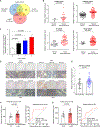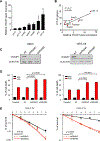CoA Synthase (COASY) Mediates Radiation Resistance via PI3K Signaling in Rectal Cancer
- PMID: 31704889
- PMCID: PMC7050829
- DOI: 10.1158/0008-5472.CAN-19-1161
CoA Synthase (COASY) Mediates Radiation Resistance via PI3K Signaling in Rectal Cancer
Abstract
Neoadjuvant radiation is standard of care for locally advanced rectal cancer. Response to radiation is highly variable and directly linked with survival. However, there currently are no validated biomarkers or molecular targets to predict or improve radiation response, which would help develop personalized treatment and ideally targeted therapies. Here, we identified a novel biomarker, coenzyme A synthase (COASY), whose mRNA expression was consistently elevated in radioresistant human rectal cancers. This observation was validated in independent patient cohorts and further confirmed in colorectal cancer cell lines. Importantly, genetic overexpression and knockdown yielded radioresistant and sensitive phenotypes, respectively, in vitro and in vivo. COASY-knockdown xenografts were more vulnerable to radiation, showing delayed tumor growth, decreased proliferation, and increased apoptosis. Mechanistically, COASY protein directly interacted with the PI3K regulatory subunit PI3K-P85α, which increased AKT and mTOR phosphorylation, enhancing cell survival. Furthermore, shRNA COASY knockdown disrupted downstream PI3K pathway activation and also hindered DNA double-strand break repair, which both led to improved radiosensitivity. Collectively, this work reveals for the first time the biological relevance of COASY as a predictive rectal cancer biomarker for radiation response and offers mechanistic evidence to support COASY as a potential therapeutic target. SIGNIFICANCE: COASY is a novel radiotherapy response modulator in rectal cancer that regulates PI3K activation and DNA repair. Furthermore, COASY levels directly correlate with radiation response and serve as a predictive biomarker.
©2019 American Association for Cancer Research.
Conflict of interest statement
Figures






Similar articles
-
Tumor Heterogeneity as a Predictor of Response to Neoadjuvant Chemotherapy in Locally Advanced Rectal Cancer.Clin Colorectal Cancer. 2019 Jun;18(2):102-109. doi: 10.1016/j.clcc.2019.02.003. Epub 2019 Feb 13. Clin Colorectal Cancer. 2019. PMID: 30935775 Free PMC article.
-
Predictive Significance of Mucinous Histology on Pathologic Complete Response Rate Following Capecitabine-Based Neoadjuvant Chemoradiation in Rectal Cancer: a Comparative Study.J Gastrointest Cancer. 2019 Dec;50(4):716-722. doi: 10.1007/s12029-018-0136-x. J Gastrointest Cancer. 2019. PMID: 29984382
-
Myoferlin: A Potential Marker of Response to Radiation Therapy and Survival in Locally Advanced Rectal Cancer.Int J Radiat Oncol Biol Phys. 2024 Nov 15;120(4):1111-1123. doi: 10.1016/j.ijrobp.2024.05.030. Epub 2024 Jun 10. Int J Radiat Oncol Biol Phys. 2024. PMID: 38866213
-
Emerging roles of non‑coding RNAs in the response of rectal cancer to radiotherapy (Review).Int J Oncol. 2021 Mar;58(3):344-358. doi: 10.3892/ijo.2021.5175. Epub 2021 Jan 22. Int J Oncol. 2021. PMID: 33650664 Review.
-
Network Mapping of Molecular Biomarkers Influencing Radiation Response in Rectal Cancer.Clin Colorectal Cancer. 2019 Jun;18(2):e210-e222. doi: 10.1016/j.clcc.2019.01.004. Epub 2019 Feb 10. Clin Colorectal Cancer. 2019. PMID: 30928329
Cited by
-
Regulation of lnc-TLCD2-1 on Radiation Sensitivity of Colorectal Cancer and Comprehensive Analysis of Its Mechanism.Front Oncol. 2021 Jul 15;11:714159. doi: 10.3389/fonc.2021.714159. eCollection 2021. Front Oncol. 2021. PMID: 34336703 Free PMC article.
-
Inherited Disorders of Coenzyme A Biosynthesis: Models, Mechanisms, and Treatments.Int J Mol Sci. 2023 Mar 21;24(6):5951. doi: 10.3390/ijms24065951. Int J Mol Sci. 2023. PMID: 36983025 Free PMC article. Review.
-
The Emerging Landscape for Combating Resistance Associated with Energy-Based Therapies via Nanomedicine.Adv Mater. 2024 Feb;36(5):e2308286. doi: 10.1002/adma.202308286. Epub 2023 Nov 28. Adv Mater. 2024. PMID: 37971203 Free PMC article. Review.
-
Radiotherapy resistance: identifying universal biomarkers for various human cancers.J Cancer Res Clin Oncol. 2022 May;148(5):1015-1031. doi: 10.1007/s00432-022-03923-4. Epub 2022 Feb 3. J Cancer Res Clin Oncol. 2022. PMID: 35113235 Free PMC article. Review.
-
Effects of the Novel PFKFB3 Inhibitor KAN0438757 on Colorectal Cancer Cells and Its Systemic Toxicity Evaluation In Vivo.Cancers (Basel). 2021 Feb 28;13(5):1011. doi: 10.3390/cancers13051011. Cancers (Basel). 2021. PMID: 33671096 Free PMC article.
References
-
- Howlader N, Noone A, Krapcho M, Miller D, Bishop K, Kosary C, et al. SEER Cancer Statistics Review, 1975–2014, National Cancer Institute [Internet] Bethesda, MD; Report No.: based on November 2016 SEER data submission, posted to the SEER web site, April 2017.
-
- Sauer R, Becker H, Hohenberger W, Rödel C, Wittekind C, Fietkau R, et al. Preoperative versus postoperative chemoradiotherapy for rectal cancer. N Engl J Med. 2004. October 21;351(17):1731–40. - PubMed
-
- Sauer R, Liersch T, Merkel S, Fietkau R, Hohenberger W, Hess C, et al. Preoperative Versus Postoperative Chemoradiotherapy for Locally Advanced Rectal Cancer: Results of the German CAO/ARO/AIO-94 Randomized Phase III Trial After a Median Follow-Up of 11 Years. JCO. 2012. June 1;30(16):1926–33. - PubMed
-
- Monson JRT, Weiser MR, Buie WD, Chang GJ, Rafferty JF, Buie WD, et al. Practice parameters for the management of rectal cancer (revised). Dis Colon Rectum. 2013. May;56(5):535–50. - PubMed
Publication types
MeSH terms
Substances
Grants and funding
LinkOut - more resources
Full Text Sources
Molecular Biology Databases
Miscellaneous

